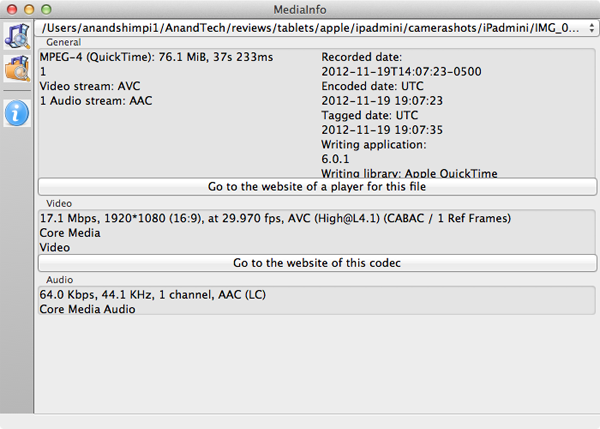iPad mini Review
by Anand Lal Shimpi & Vivek Gowri on November 20, 2012 6:10 PM ESTCamera
The iPad mini features a 1.2MP front facing FaceTime HD camera and a 5MP rear facing iSight camera. The rear camera shoots photos at 2592 x 1936, the same resolution as the 4th generation iPad. Both of the new iPads have the same f/2.4 lens, however the mini features a wider field of view thanks to its shorter 3.3mm focal length.
| Camera Comparison | |||||||
| Sensor | Resolution | Compressed JPEG Size | Aperture | Focal Length | |||
| Apple iPad 4 | 5MP | 2592 x 1936 | 3.4MB | f/2.4 | 4.3mm | ||
| Apple iPad 2,4 | 0.7MP | 960 x 720 | 344KB | f/2.4 | 2.0mm | ||
| Apple iPad mini | 5MP | 2592 x 1936 | 3.1MB | f/2.4 | 3.3mm | ||
| Apple iPhone 5 | 8MP | 3264 x 2448 | 3.1MB | f/2.4 | 4.1mm | ||
| Apple iPod Touch 5 | 5MP | 2592 x 1936 | 3.1MB | f/2.4 | 3.3mm | ||
Still performance of the rear facing camera is very similar to the 5th generation iPod Touch, and not as good as the 4th generation iPad.
The front facing camera is also similar to what you find in the iPhone 5 and 5th generation iPod Touch:
| Camera Comparison | |||||||
| Sensor | Resolution | Compressed JPEG Size | Aperture | Focal Length | |||
| Apple iPad 4 | 1.2MP | 1280 x 960 | 426KB | f/2.4 | 2.2mm | ||
| Apple iPad 2,4 | 0.3MP | 640 x 480 | 105KB | f/2.4 | 1.8mm | ||
| Apple iPad mini | 1.2MP | 1280 x 960 | 372KB | f/2.4 | 2.2mm | ||
| Apple iPhone 5 | 1.2MP | 1280 x 960 | 400KB | f/2.4 | 2.2mm | ||
| Apple iPod Touch 5 | 1.2MP | 1280 x 960 | 406KB | f/2.4 | 2.2mm | ||
Performance of the front facing camera is decent, and a significant improvement compared to the iPad 2 (you can see comparison shots in the gallery above):
Although I'm continually impressed by folks using tablets as their primary cameras at trade shows and press events, I don't believe the same standards apply to tablets as they do to smartphone camera systems. That being said, it's good to see continued improvements here.
Video
The iPad mini shoots 1080p video from its rear camera and 720p on the front. It looks like Apple is borrowing from the iPhone 5's encoder improvements here as video shot with the rear camera is encoded using High Profile H.264 (L4.1) at 17.1Mbps. The improvement in encode quality is possibly unlocked through software/firmware rather than an actual hardware change since this is still running on A5r2 silicon. In our iPhone 5 review, Brian pointed out that the A6 uses the same encode/decode hardware as the A5 but its full capabilities weren't unlocked until the A6. Given that encode quality has also improved on the A5r2 based iPad mini, it would seem that Apple limited earlier designs either due to a lack of time or to stagger its improvements across generations.

The front facing camera shoots baseline video at roughly 10.6Mbps, a huge improvement over the iPad 2 and iPad 3:

Video quality is definitely good enough for web use:


















140 Comments
View All Comments
protomech - Tuesday, November 20, 2012 - link
Top of the summary gives it away:"In my first week with the iPad mini, it quickly became the iPad I actually wanted to carry around. The mini's form factor is really where all of the innovation is. It's thin, light and an almost perfect balance of functional screen size and portability. I really love this form factor."
By specs, the mini is unimpressive. It's using a SOC introduced in early 2011. We've been accustomed to high resolution mini-tablets from B&N, Amazon, Google, etc. It has less memory and costs significantly more (particularly for higher SKUs).
But, at least for the reviewer, the form factor trumps all these things, at least for purposes of a "carry computer". Thinner and lighter than the 7" tablet comparison, with significantly more usable display space (Android 4.x soft buttons do not help here) in nearly the same frontal area.
Would it be a better product if it sported an A6X SOC and a retina display? Certainly, on paper. It also likely would need a ~25 Wh battery and substantial increases in both weight and thickness .. same sort of changes from the iPad 2 to iPad 3.
iPad mini should have been introduced last year when the 32nm SOC was available IMO .. it would have provided a useful bifurcation vs the 3rd gen iPad's bulk gains, and perhaps we'd have an A6 SOC in the iPad mini today.
seanleeforever - Tuesday, November 20, 2012 - link
not sure how that quote answers Jorange's questions. but that's the internet nowadays.protomech - Tuesday, November 20, 2012 - link
Is it? It looks like it's a reply to Greg512. Certainly that's how I intended it.But, as you say, that's the internet nowadays.
ltcommanderdata - Tuesday, November 20, 2012 - link
I doubt Apple could have shipped a 32nm SoC last year in volume. The A5r2 was already the first shipping SoC produced on Samsung's 32nm process, ahead of Samsung's own designs, when it launched on the iPad2,4 in March 2012. And that was only used for low volume test production with the 45nm A5 iPad 2 continuing to be available. Apple prioritizing the iPhone 5 to receive a 32nm SoC first and waiting until now for high volume 32nm production to introduce 32nm iPad Mini, 5th gen iPod Touch, and iPad 4 makes sense.protomech - Tuesday, November 20, 2012 - link
Good point.. I thought it had shipped late last year.KoolAidMan1 - Wednesday, November 21, 2012 - link
"By specs, the mini is unimpressive."GPU performance is still surprisingly good, better than even the newest Android-running hardware. What is it with other companies not keeping up with Apple's older hardware?
Greg512 - Wednesday, November 21, 2012 - link
Yea, the GPU is good. But, for the price, the screen, CPU, and RAM are kinda poor. The Mini performs well now, but I question its long-term viability.marvdmartian - Wednesday, November 21, 2012 - link
Typical Apple product, that will sell like hotcakes: getting less, paying more, nothing new.drx11 - Sunday, November 25, 2012 - link
---------------------------------------------------------RE: Not a bad product by marvdmartian on Wednesday, November 21, 2012
Typical Apple product, that will sell like hotcakes: getting less, paying more, nothing new.
---------------------------------------------------------
Typical Fandroid, never sees the forest for the trees.
Apple is the best and has been so since 2007 - at building SoC.
Apple is the best at supporting its devices long term.
Now with iOS 6 - which is mostly supported (not all the features) for an old 3GS phone - you could argue you are getting less - maybe on the older devices (no Siri, Apple Maps is not as good as as Google Maps ... right now... etc..)
Still iOS 5 is very nice for older things and Android/Google/Moto/Samsung/HTC has rarely updated their "better" hardware at all ... you can blame that on the carriers all you want, but that is also what you are buying.
Buying more often, spending more time doing something that maybe should just work?
I know Google is trying (or starting to), but they really have almost no support for the majority (75%+ ) of the devices in their 'ecosystem'. What's the point of better hardware when it runs slower/worse from the start and never gets updated?
Alucard291 - Monday, November 26, 2012 - link
Did you have a joint before you wrote this drivel? Or does your mind work this bad drug free? ^^Good SoCs? Are you serious? Just because people work'd the shaft so hard when A6 came out doesn't mean that Cortex A9 based soc is viable coming into 2013.
Apple is currently behind the curve on both tech processes (28 nm vs 32 nm) and performance (cpu and ram speed but not gpu)
In case of ipad mini. You get less. (2 year old tech) you pay more (than any competition out there). But somehow we miss the forest for the trees?
Oh but it supports the amazing dated and feature free ios6! That's great. Except well.. (opinion incoming) I don't like ios. I find it restrictive and boring.
So your point is?